A company’s strategy often lives in static slide decks, reviewed quarterly, and disconnected from the team’s daily rhythm. This creates a gap between ambitious goals and the actual work required to achieve them, leaving teams feeling misaligned and unsure of their impact.
The right OKR software bridges this gap by transforming strategy from a document into a live playbook. It connects high-level objectives directly to the projects and workflows your team executes every day. Platforms like monday work management are built to provide this unified view, turning scattered efforts into focused momentum.
This guide walks through the best OKR software platforms available, what essential features to look for, and how to select the right one for your team. We will cover everything from pricing to key capabilities, giving you the information needed to make a confident decision.
Get started with monday work managementKey takeaways
- OKR software connects high-level company objectives to the projects and tasks your team works on every day.
- A strong OKR platform makes progress visible, improves alignment, and supports faster decision-making.
- monday work management helps teams manage OKRs and day-to-day work on the same platform.
- When comparing tools, look at goal alignment, reporting, collaboration, and integrations alongside pricing.
What is OKR software?
OKR software functions as the central playbook for your company’s most important goals. It is the digital space where an ambitious vision gets translated into a transparent, actionable game plan that everyone can rally behind. This process goes beyond simple task tracking. It connects every action to a meaningful, measurable outcome.
The platform guides your team in defining its ambitious objectives (what you want to accomplish) and the measurable key results that prove you’re on track. This straightforward framework creates focus and aligns everyone from the top down so the entire organization moves with a shared purpose.
This is how strategy is pulled out of static slide decks and woven into the daily rhythm of your team. OKR software provides a real-time view of how individual work directly impacts the company’s most critical goals, transforming scattered efforts into focused, confident execution.
Why your organization needs an OKR platform
Your team is full of talented people doing great work, but can everyone articulate how that work drives the company forward? This common gap between daily effort and strategic impact is where momentum is often lost, leaving teams feeling disconnected from the bigger picture.
An OKR platform connects your high-level strategy to your team’s day-to-day execution. When everyone’s efforts align with the same company goals, scattered tasks turn into a unified push for results. In addition to tracking goals, an OKR platform helps build a clear, confident path toward achieving them.
Connect strategy to execution
Setting big goals is the easy part. The real challenge is helping every person see how their work fits into that vision. A strong OKR platform creates a direct, visible line from the company’s top objectives down to individual projects. This keeps strategy from sitting in a document and turns it into a clear plan everyone works from.
This clarity eliminates the guesswork that drains energy and confidence. When your team can instantly see how their projects contribute to the company’s success, they stop wondering if their work matters and start focusing on making a bigger impact.
Enable real-time progress tracking
Waiting for a quarterly review to discover you’re off course makes it hard to react in time. An OKR platform provides a live dashboard of your progress, so you always know exactly where you stand. This empowers leaders to spot roadblocks and make smart pivots before small issues become major setbacks.
With this real-time visibility, your entire organization can move from a reactive posture to a proactive one while making confident, data-backed decisions every step of the way.
Build transparency across teams
Silos make it difficult for great strategies to succeed. When teams operate in isolation, they cannot see how their work impacts others, leading to duplicated efforts and missed opportunities for collaboration. An OKR platform breaks down these walls by making goals and progress visible to everyone.
This shared perspective supports a culture of accountability and teamwork centered on common objectives. Instead of focusing only on their own to-do lists, people begin to see the larger picture, enabling them to help each other solve problems and drive toward collective wins.
Try monday work management12 best OKR software platforms for goal management
Selecting the right OKR software is a pivotal move for any team aiming to turn ambition into achievement. While many options exist, the key is finding a platform that plugs directly into your team’s existing workflows, rather than one that imposes a rigid new process.
The most effective platforms do more than track goals. They support alignment and confidence across the entire organization. By connecting high-level strategy to daily tasks, they give everyone a clear line of sight into progress and make it easy to stay focused on what truly matters.
We’ve laid out the top players to help you make an informed decision. Here, you’ll get a straightforward look at each platform’s strengths, its ideal user base, and its starting price so you can confidently choose the one that best supports your team.
1. monday work management
Within the monday work management platform, scattered objectives turn into streamlined execution. The platform specializes in connecting high-level strategic goals to daily tasks and workflows, making it ideal for organizations seeking unified goal management and project execution. Teams gain complete visibility from quarterly objectives down to individual action items so everyone stays aligned on what matters most.

Use case:
This all-in-one platform connects strategic planning with operational execution, enabling teams to track progress from company-wide goals down to individual items.
Key features:
- Goal cascading and alignment: Connect company objectives to team goals and individual tasks through customizable hierarchies that maintain strategic focus across all organizational levels.
- Real-time progress tracking: Monitor OKR advancement through visual dashboards and automated progress updates that keep stakeholders informed without manual reporting.
- Cross-departmental workflows: Coordinate initiatives across teams with shared boards, dependencies, and collaborative workspaces that break down organizational silos.
Pricing:
- Free: $0 forever for up to 2 seats, limited to 3 boards and basic features.
- Basic: $9/user/month with unlimited items and viewers.
- Standard: $12/user/month, adding timeline views and automation capabilities.
- Pro: $19/user/month with private boards and advanced reporting.
- Enterprise: Custom pricing with enterprise-scale features and dedicated support.
Why it stands out:
- Seamless integration: Unlike standalone OKR platforms, monday work management connects objectives directly to project execution, eliminating the disconnect between strategy and daily work.
- Intuitive visuals: Transform complex goal structures into intuitive, color-coded boards that make progress immediately visible to all stakeholders.
- Scalable flexibility: Adapt the platform to any organizational structure or methodology, from simple team goals to complex multi-departmental initiatives.
Advanced AI features:
- AI Assistant: Accelerate work by using AI to generate tasks from goals, summarize long updates, and draft project-related communications.
- Automated task generation: Break down key results into actionable tasks automatically to get projects started faster.
- Formula builder: Create custom formulas for tracking progress using simple text prompts, making data analysis more accessible.
Automations:
- No-code workflow builder: Create custom automation recipes that trigger actions based on goal progress, deadlines, or status changes without technical expertise.
- Pre-built recipes: Access 200+ automation recipes to streamline workflows, including sending progress notifications and managing quarterly review tasks.
- Enterprise-scale processing: Handle up to 250,000 automation actions monthly in enterprise plans, supporting complex multi-team goal coordination.
Integrations:
- Comprehensive connectivity: Connect with 200+ third-party applications including Slack, Microsoft Teams, Google Workspace, and Salesforce for unified goal tracking.
- API access: Build custom integrations and data flows that sync OKR data with existing business intelligence and reporting systems.
- Enterprise tool ecosystem: Native integrations with popular enterprise platforms ensure goal data flows seamlessly across your technology stack.
OKR software features:
- Quarterly reporting dashboards: Generate comprehensive OKR performance reports with visual breakdowns of achievement rates, trend analysis, and team contributions.
- Company-wide objective boards: Maintain transparency with centralized goal visibility that allows all team members to understand how their work contributes to larger objectives.
- Smart grading system: Automatically calculate OKR scores based on key result completion, providing consistent performance measurement across all goals.
2. Asana
Asana excels at creating a direct line between high-level strategy and the daily tasks that move your business forward. While it’s a comprehensive work management platform first, its integrated Goals feature is an excellent choice for teams who want their OKRs to live alongside the work they drive.
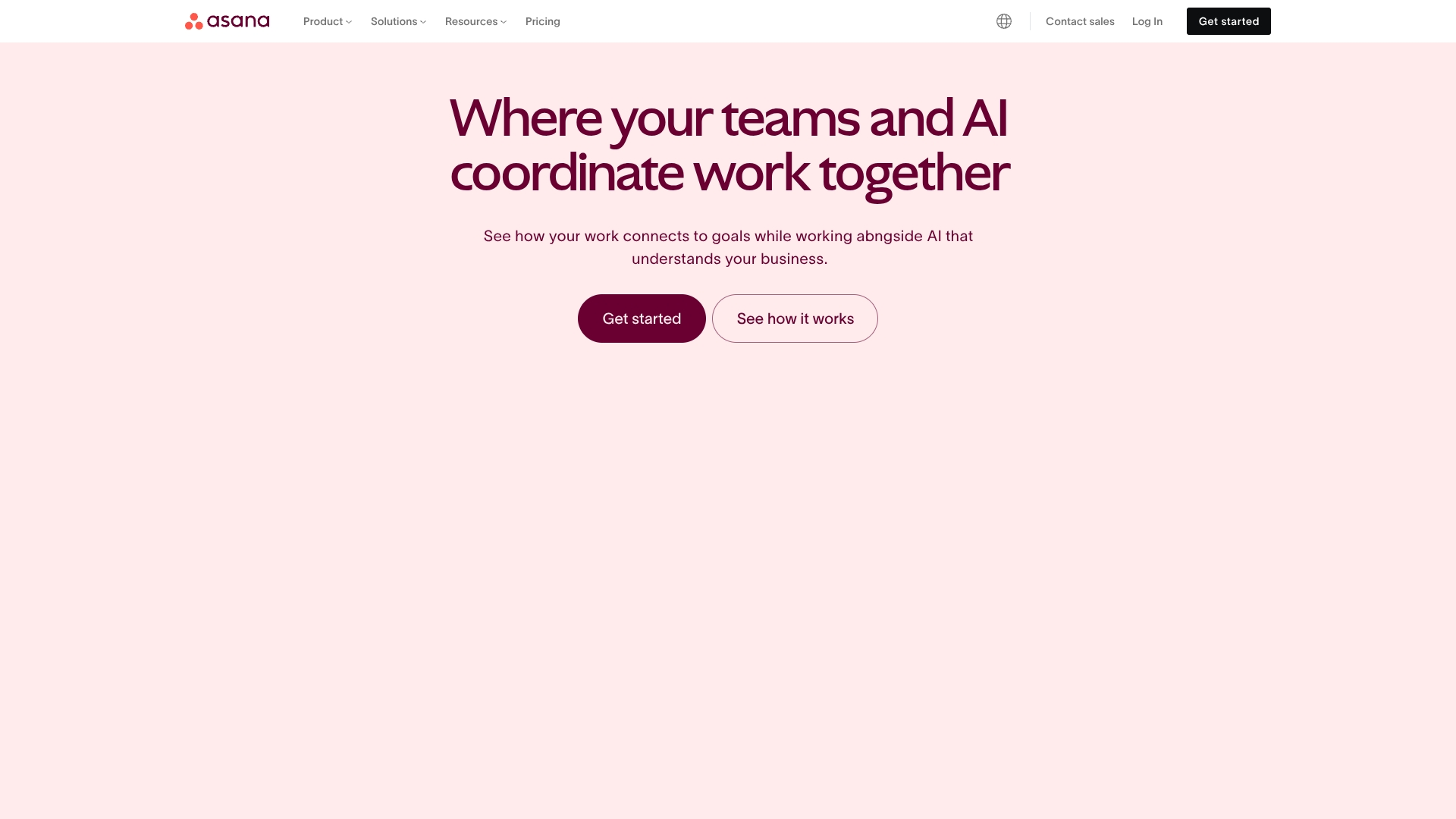
Use case:
Asana’s Goals feature establishes a single source of truth where OKRs, projects, and tasks coexist, ensuring strategic objectives remain connected to the work that actually gets done.
Key features:
- Integrated goal tracking: Connect objectives directly to projects and tasks for automatic progress updates as work gets completed.
- Hierarchical goal structure: Create company-wide objectives with supporting team goals that ladder up to bigger initiatives.
- Real-time visibility: Track progress toward key results automatically as underlying projects advance, eliminating manual status updates.
Pricing:
- Personal: Free for up to 10 teammates. Includes unlimited tasks, projects, messages, basic views, and 100+ integrations.
- Starter: $10.99/user/month (billed annually) with AI features and advanced views.
- Advanced: $24.99/user/month (billed annually). This plan adds the Goals feature for OKR management.
- Enterprise: Custom pricing with advanced security and admin controls.
- Enterprise+: Custom pricing with compliance features and data residency options.
A 50% discount is available for eligible nonprofits on annual Starter or Advanced plans.
Considerations:
- The Goals feature is only available on the Advanced plan and above, which may limit access for smaller teams.
- Some users find the interface for updating goal status confusing and not entirely intuitive.
3. ClickUp
As an all-in-one workspace, ClickUp provides a highly customizable environment where strategic goals and daily tasks converge. The platform’s strength lies in its flexible OKR templates and seamless integration between objectives and execution, making it ideal for teams that demand adaptability without sacrificing alignment.
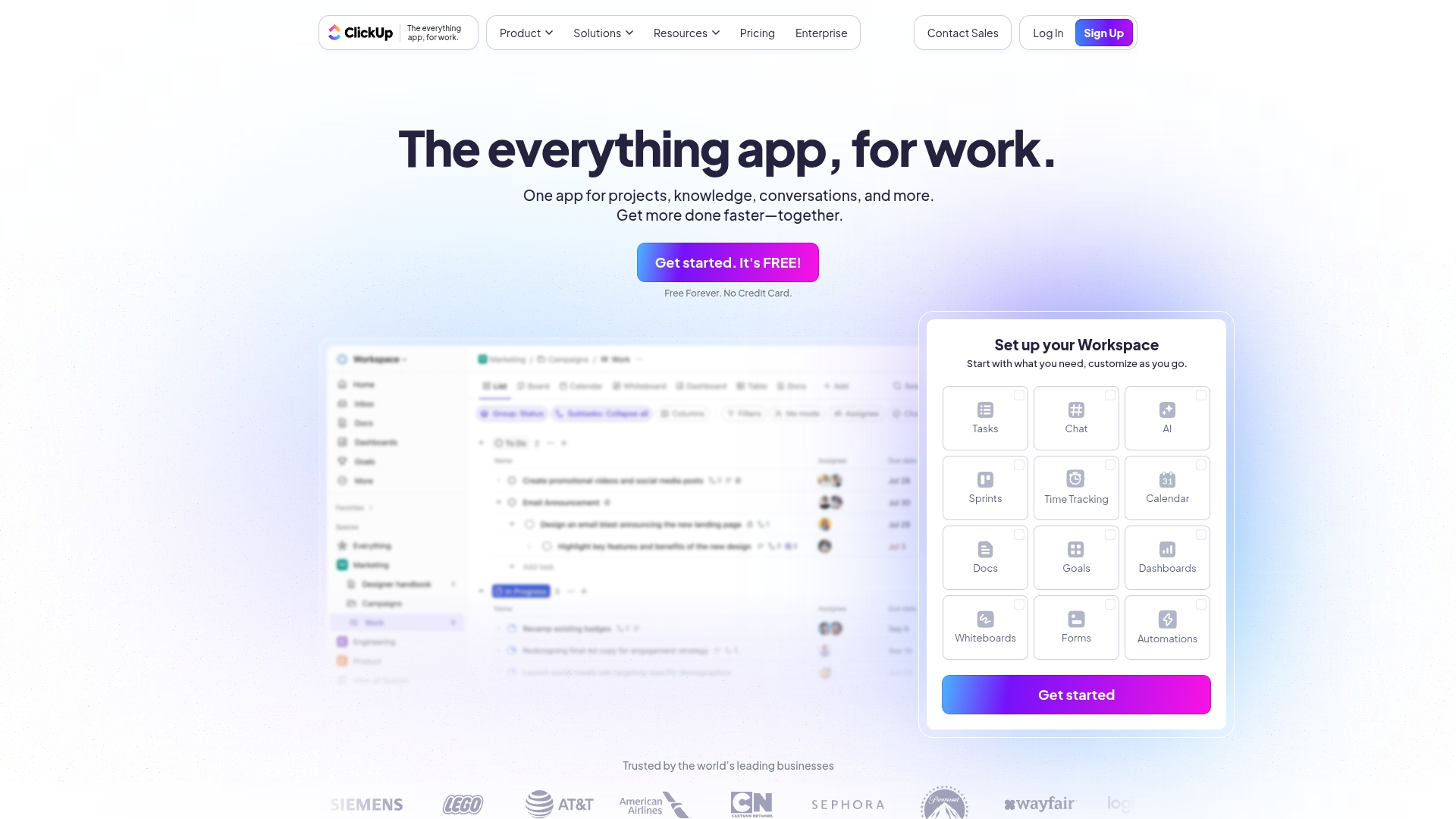
Use case:
ClickUp is built for teams seeking an integrated OKR platform that connects high-level objectives directly to the granular tasks required to achieve them, all within a single, highly configurable workspace.
Key features:
- AI-powered OKR generation: ClickUp Brain analyzes your existing tasks and activities to suggest relevant, contextual objectives and key results.
- Real-time progress tracking: Multiple visualization options including Gantt charts, Kanban boards, and dashboards provide instant visibility into goal advancement.
- Task-to-goal linking: Direct connections between daily work and strategic objectives ensure every activity contributes to meaningful outcomes.
Pricing:
- Free Forever: $0 (unlimited tasks, basic OKR features).
- Unlimited: $7/user/month (includes Goals & Portfolios, unlimited storage).
- Business: $12/user/month (unlimited dashboards, advanced reporting).
- Enterprise: Custom pricing (white labeling, advanced permissions).
- ClickUp Brain (AI features): Additional $5/member/workspace/month on paid plans.
Considerations:
- The extensive feature set can overwhelm new users and create a steep learning curve for teams wanting simple OKR management software.
- OKR functionality may feel “hidden” within the platform’s comprehensive interface, lacking the focused experience of dedicated objectives and key results software.
4. Smartsheet
By leveraging the familiar structure of a spreadsheet with enterprise-grade power, Smartsheet offers a unique approach to OKR management. The platform excels at connecting strategic objectives directly to the work that drives them, making it perfect for organizations that want comprehensive visibility from goals to execution.
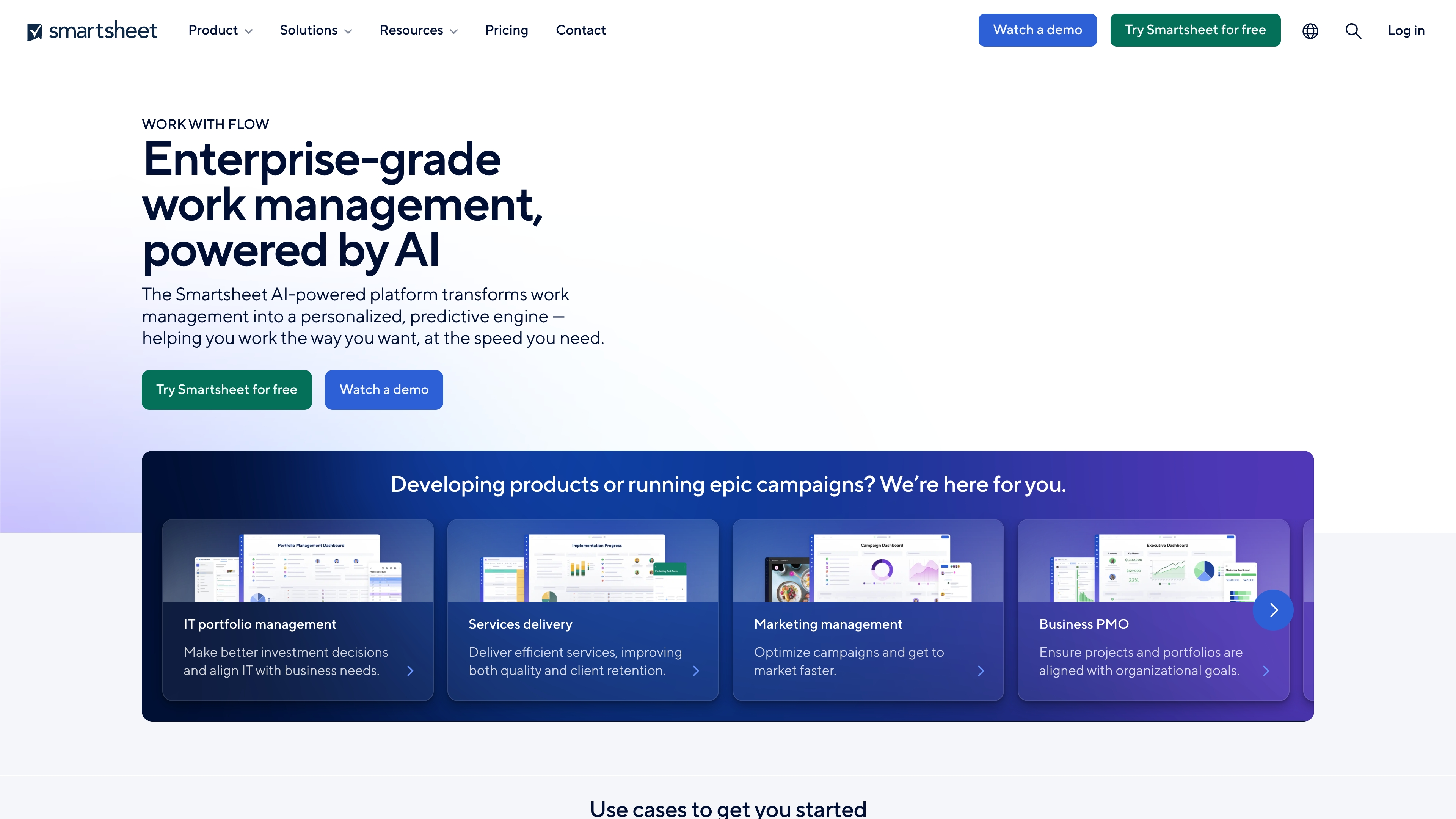
Use case:
Smartsheet is ideal for enterprises and teams that need to manage OKRs within the same platform where they execute projects, providing seamless alignment between strategic goals and daily work.
Key features:
- OKR tracker templates: Pre-built templates with dashboards, tracking sheets, and intervention reports for objectives at risk.
- Real-time collaboration: Teams can update progress, leave comments, and share files directly within OKR sheets.
- Advanced automation: Automated alerts and reminders keep OKRs top-of-mind without manual follow-up.
Pricing:
- Pro: $7/user/month (billed annually) for up to 10 users, including unlimited sheets and 250 automations per month.
- Business: $25/user/month (billed annually) for a minimum of 3 users, with unlimited automations and advanced features.
- Enterprise: Custom pricing for large organizations seeking AI tools, single sign-on (SSO), and premium security.
- Advance: Custom pricing for premium capabilities and dedicated support.
Considerations:
- Requires manual setup and good platform knowledge to customize OKR tracking effectively.
- Lacks specialized OKR features like alignment visualizations found in dedicated objectives and key results software.
5. Wrike
For project-driven organizations, Wrike provides a robust platform where OKR management is deeply integrated with complex workflow execution. It specializes in connecting strategic objectives directly to daily work, making it ideal for teams that need to balance sophisticated projects with goal achievement.
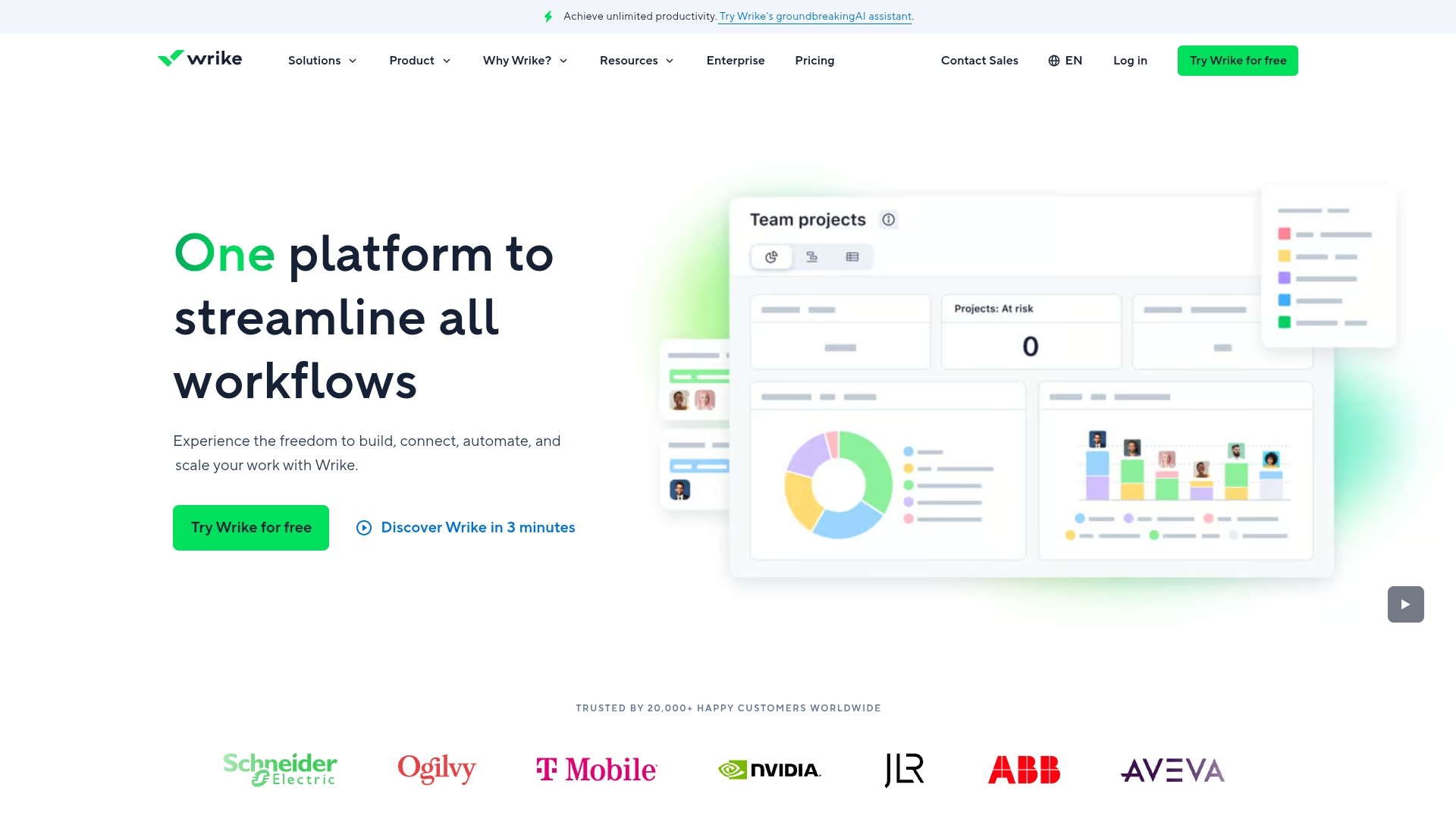
Use case:
Wrike excels at integrating OKR tracking with project management, providing teams with a unified workspace where strategic goals and operational tasks work in harmony.
Key features:
- Multi-level OKR creation and tracking across company, department, team, and individual levels.
- Real-time dashboards with automated progress reporting and executive visibility.
- Selective sharing capabilities that allow leadership to privately plan objectives before company-wide rollout.
Pricing:
- Free: $0/month for basic project and task management with limited features.
- Team: $10/month per user (billed annually) for small teams with unlimited projects and basic OKR tracking.
- Business: $25/month per user (billed annually) for advanced OKR features, resource planning, and custom reporting.
- Enterprise: Custom pricing for large organizations with advanced security and unlimited users.
- Pinnacle: Custom pricing for complex workflows with advanced analytics and extensive integrations.
Considerations:
- The extensive feature set can create a steep learning curve for teams seeking simple OKR tracking.
- Premium pricing for advanced OKR capabilities may exceed budgets for smaller organizations focused solely on objectives and key results software.
6. Profit.co
Profit.co is a dedicated OKR platform built to support deep methodology, combining goal-setting with performance management and employee engagement tools. Its specialization in the OKR framework, complete with built-in coaching features, makes it ideal for organizations seeking a comprehensive objectives and key results software solution.

Use case:
Profit.co is designed for organizations that want to move beyond basic OKR tracking to create a comprehensive strategy execution platform that connects goals with daily tasks and performance reviews.
Key features:
- PEEL methodology: Structured quarterly process for planning, executing, engaging, and learning from OKRs.
- Integrated task management: Links daily activities directly to key results for complete visibility.
- Performance management integration: Combines OKR tracking with 360-degree feedback and performance reviews.
Pricing:
- Starter plan: $7/user/month (billed annually).
- 30-day free trial: Available with no credit card required.
- Enterprise pricing: Custom quotes available for larger organizations.
Considerations:
- Learning curve can be steep due to extensive feature set and comprehensive functionality.
- May offer more capabilities than smaller teams or simpler OKR implementations require.
7. Weekdone
Designed for simplicity and focus, Weekdone turns quarterly goal-setting into a structured weekly rhythm for small teams and startups. The platform specializes in combining OKRs with weekly check-ins, making it perfect for growing companies that need straightforward objectives and key results software without overwhelming complexity.
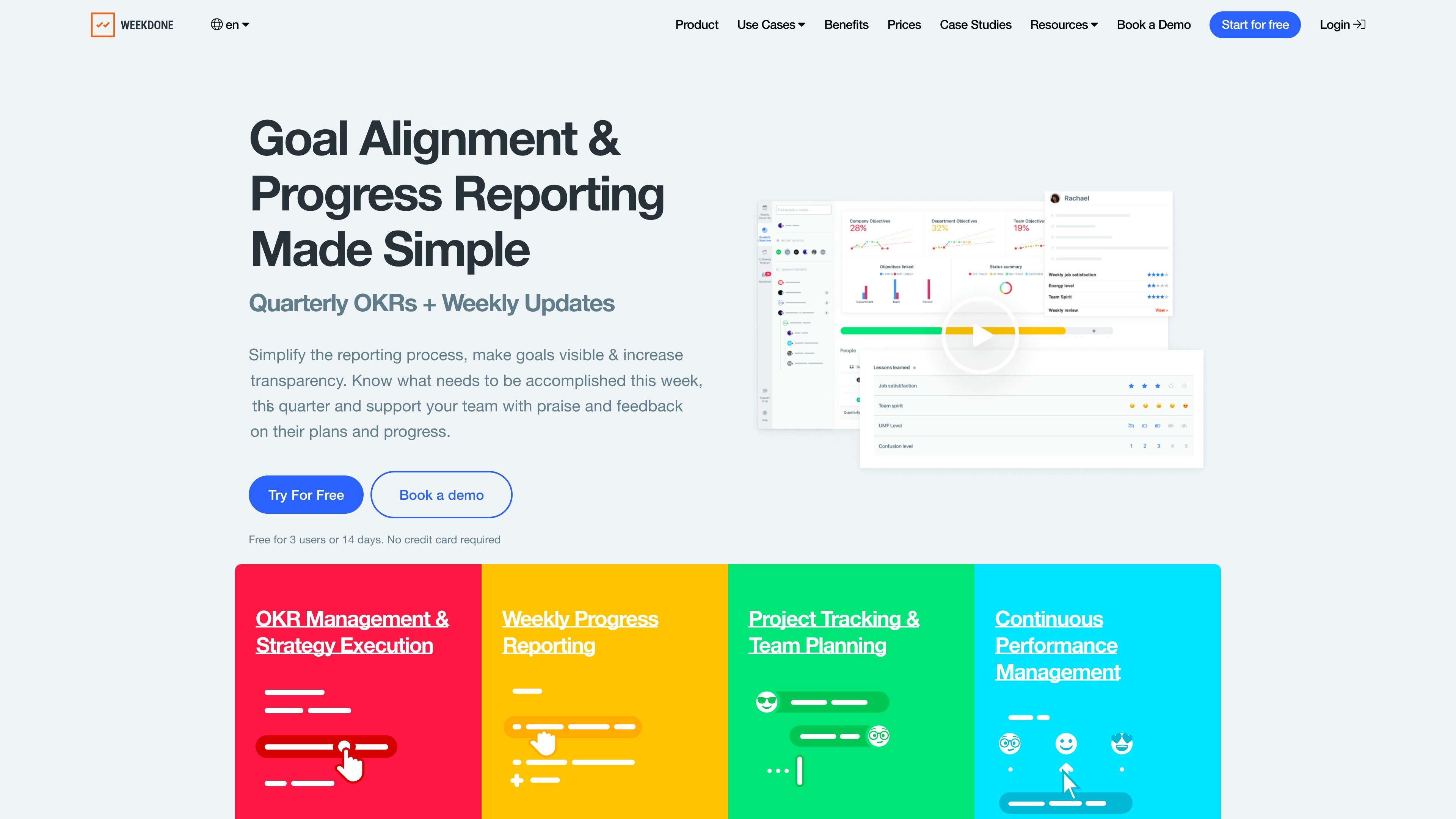
Use case:
Weekdone helps small teams and startups implement OKRs effectively by connecting weekly progress updates directly to quarterly objectives, creating transparency and accountability without complex setup requirements.
Key features:
- Weekly check-ins with PPP methodology: Track Plans, Progress, and Problems to maintain alignment between daily tasks and quarterly goals.
- Visual OKR hierarchy: See how individual objectives connect to company-wide goals through interactive tree views and dashboards.
- Guided OKR setup: Built-in examples and writing tools help teams new to the OKR methodology get started quickly.
Pricing:
- Free plan: $0/month for up to 3 users with all features included.
- Paid plans: Starting at $90/month for 10 users (pricing decreases per user as team size grows).
- Annual discount: 20% savings when billed annually.
- Free trial: 14-day trial available with no credit card required.
Considerations:
- Limited customization options may feel restrictive for teams with specific workflow requirements.
- Pricing jumps significantly from the 3-user free plan to paid tiers, which can be challenging for small teams of 4-5 people.
8. Perdoo
Perdoo makes strategy execution a visual and trackable process, uniquely combining OKRs and KPIs in a single interface to align distributed teams. The platform specializes in connecting company goals to individual contributions, making it ideal for organizations seeking strategic clarity.
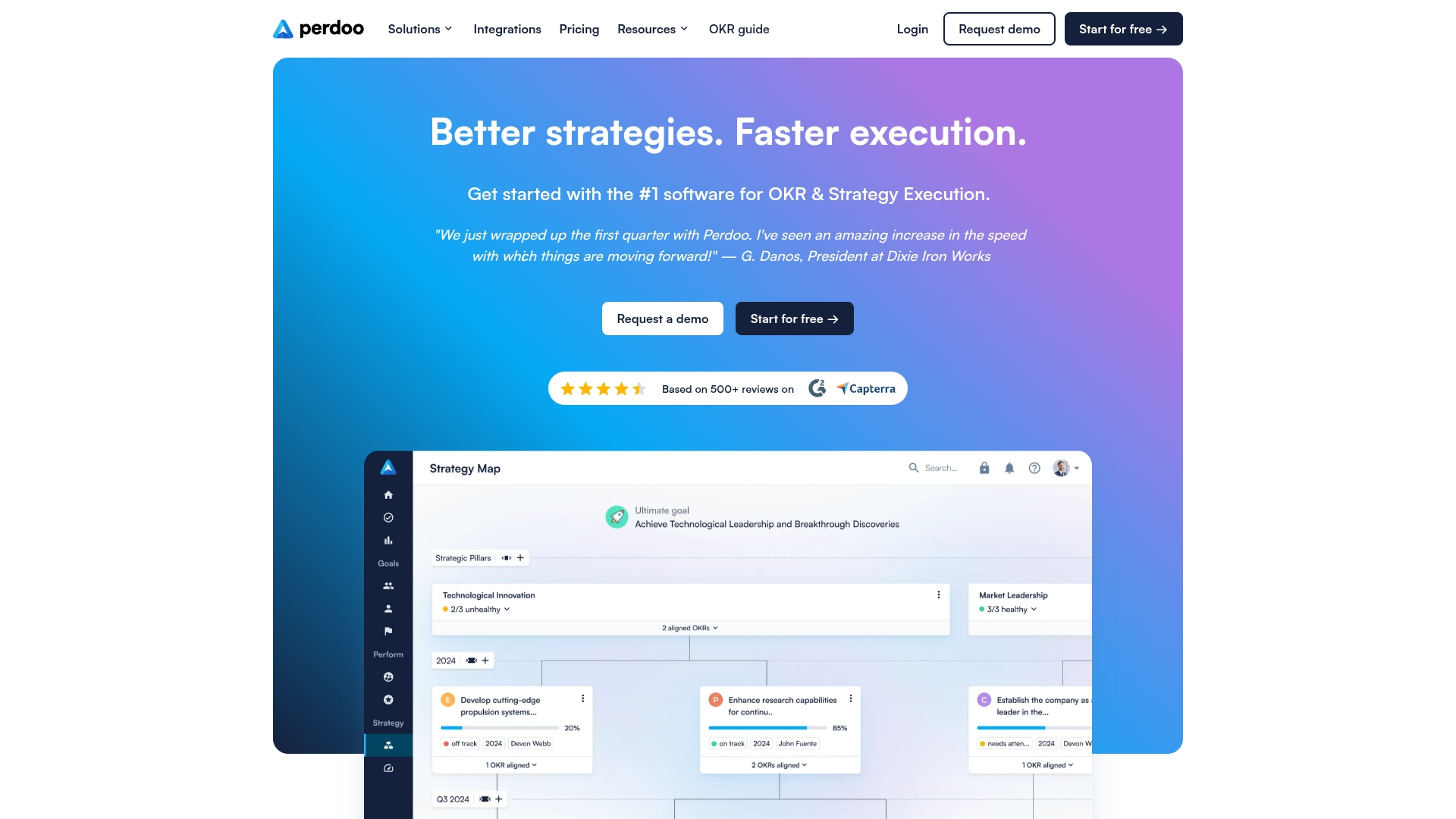
Use case:
Perdoo functions as a comprehensive objectives and key results software that helps organizations translate strategic vision into measurable outcomes through visual strategy mapping and integrated performance tracking.
Key features:
- Strategy Map visualization that connects long-term strategic pillars to quarterly OKRs for enhanced clarity.
- Integrated OKR and KPI tracking within a single platform for holistic performance management.
- Weekly check-ins and progress reporting with customizable dashboards and automated email updates.
Pricing:
- Free Plan: €0 per user/month for up to 5 users.
- Premium Plan: €8 per user/month (annual billing) or €10 per user/month (monthly billing), minimum 10 users.
- Supreme Plan: €10 per user/month (annual billing) or €13 per user/month (monthly billing), minimum 10 users.
- View-only licenses: Available starting from €1.50 per user/month (Supreme plan only).
- Annual billing: Provides 10% discount compared to monthly billing.
- NGOs and NPOs: Receive an additional 25% discount.
Considerations:
- Mobile app functionality is limited compared to the web platform, creating a disjointed experience for on-the-go users.
- Some users report occasional bugs and technical issues, particularly when new features are rolled out.
9. 15Five
15Five places continuous performance management at the heart of goal achievement, integrating robust OKR tracking with weekly check-ins and employee engagement. This holistic approach makes it ideal for companies prioritizing people development alongside strategic alignment.
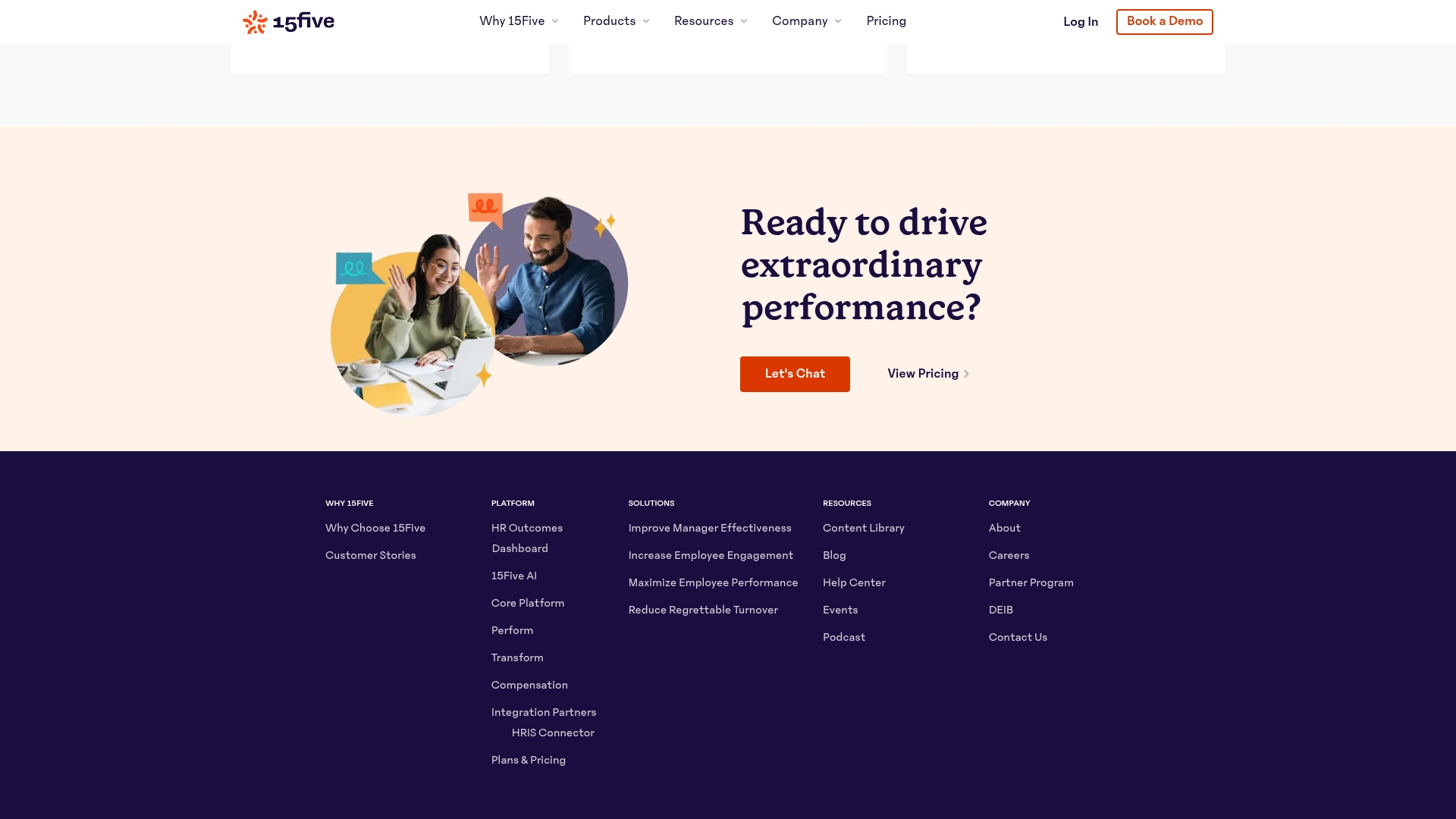
Use case:
15Five is built to create a unified performance management system that connects individual objectives to company-wide strategic priorities through continuous feedback loops.
Key features:
- Parent-child OKR hierarchy that visually connects individual goals to company objectives.
- Real-time progress tracking integrated with weekly check-ins and performance reviews.
- Research-backed methodology informed by The Center for Evidence-Based Management.
Pricing:
- Engage: $4/user per month (billed annually).
- Perform: $10/user per month (billed annually).
- Total Platform: $16/user per month (billed annually).
- Manager coaching add-ons: Starting at $29/manager per month.
- Compensation package: $9/user per month for existing customers.
Considerations:
- OKR functionality may not be as robust as dedicated objectives and key results software platforms.
- Interface can feel overwhelming initially due to the extensive feature set across performance management.
10. Lattice
Engineered for HR-driven organizations, Lattice weaves OKR tracking directly into the fabric of performance reviews and employee development. The platform transforms goal-setting from a quarterly chore into a continuous performance engine, making it the go-to choice for aligning individual growth with company objectives.
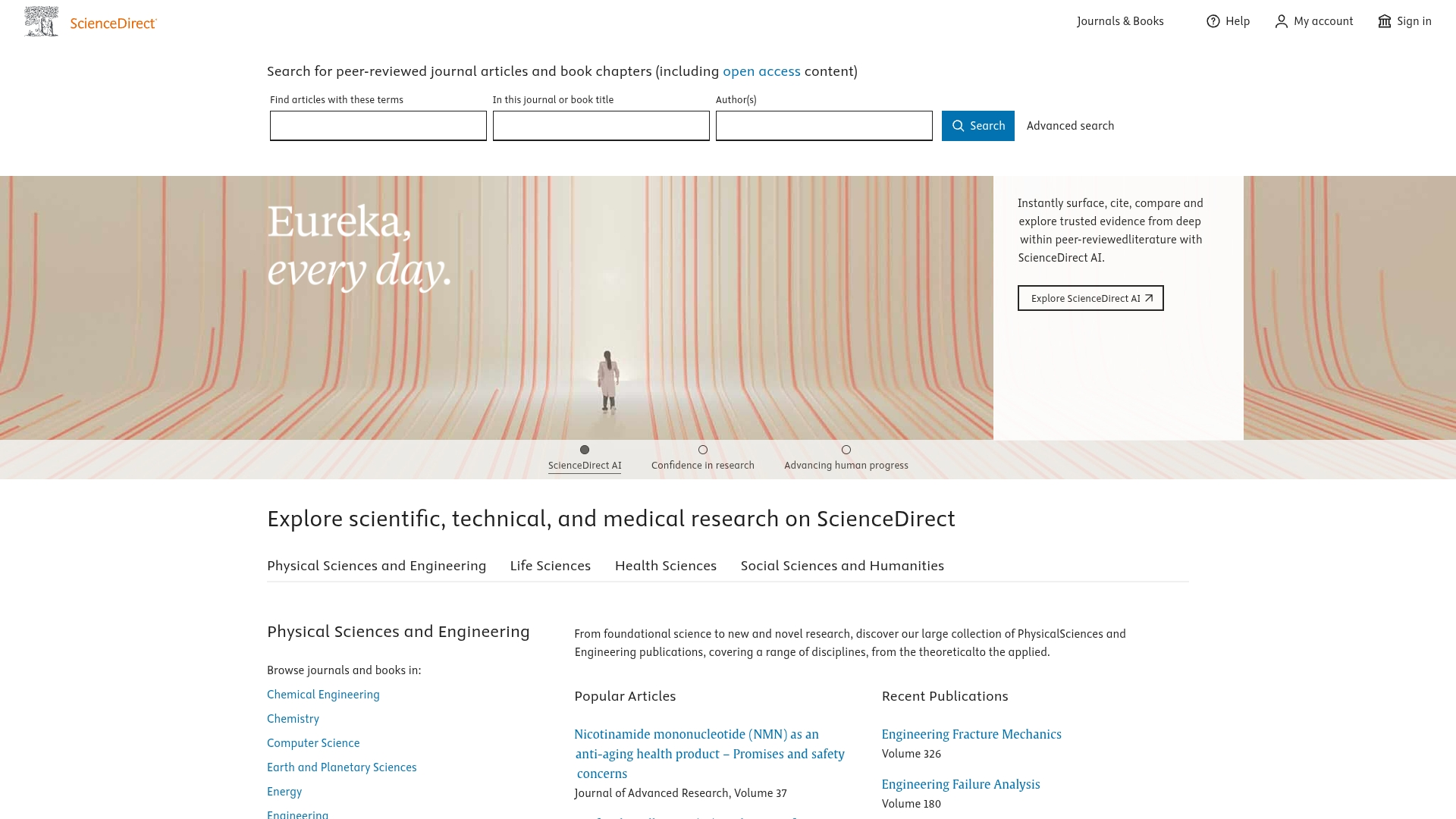
Use case:
Lattice excels at connecting OKR management with comprehensive people management, creating a unified system where goals, feedback, and performance reviews work together to drive both individual and organizational success.
Key features:
- Cascading alignment: Connect individual OKRs to team and company objectives with visual goal mapping that shows how everyone’s work contributes to the bigger picture.
- Integrated performance reviews: Seamlessly tie OKR progress into performance evaluations, creating a holistic view of employee development and achievement.
- Real-time progress tracking: Monitor goal advancement through intuitive dashboards and visual trackers that keep objectives visible and actionable across the organization.
Pricing:
- Performance Management: Starts at $11/user/month.
Considerations:
- Interface can feel overwhelming for new users, with some finding the goal-setting process clunky and time-consuming.
- Limited flexibility in certain areas, such as viewing goals without owners and restricted employee control over personal goal-setting.
11. Betterworks
Betterworks offers an enterprise-grade solution that elevates OKR management into a continuous performance driver. The platform specializes in connecting objectives with ongoing conversations, feedback, and talent development, making it ideal for large organizations seeking comprehensive performance management beyond basic goal tracking.
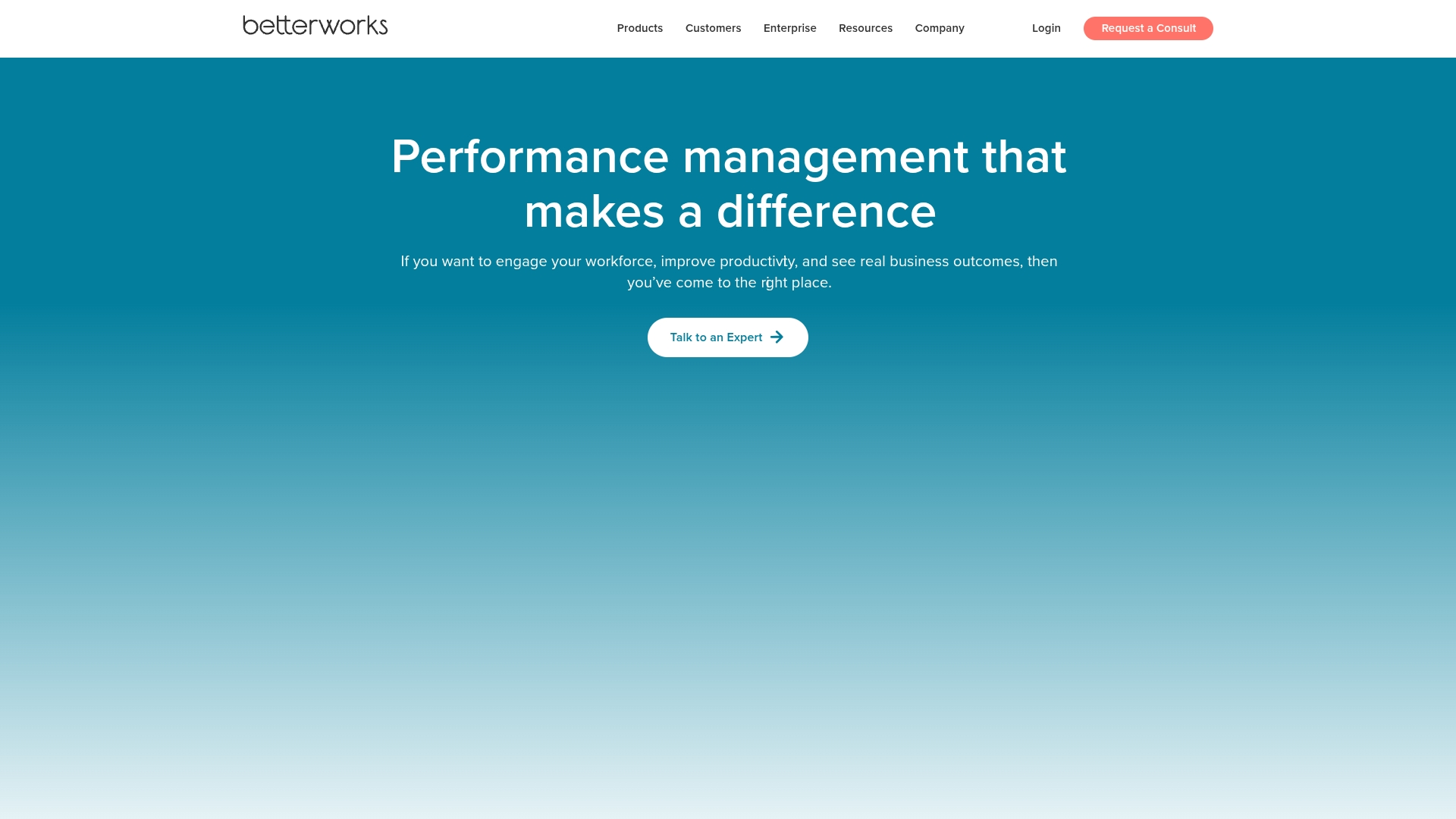
Use case:
Betterworks serves as an integrated performance management platform that makes OKRs a living part of daily work rather than static quarterly documents.
Key features:
- AI-powered Goal Assist that helps employees write clear, actionable objectives and provides instant coaching for better alignment.
- Continuous goal management with weekly updates and progress tracking embedded directly into existing workflows like Slack and Jira.
- Integrated performance reviews that automatically surface goal completion data for fair, weighted assessments.
Pricing:
- Mid-Market/Commercial: Starting at 500 employees, custom pricing available.
- Enterprise: Starting at 2,500-3,000 employees, custom pricing available.
- Employee Engagement Standalone: Contact sales for details.
All plans require contacting Betterworks directly for personalized quotes.
Considerations:
- The comprehensive feature set can create a steep learning curve, with some users finding the depth overwhelming compared to simpler OKR tools.
- Per-user licensing model charges for all employees even if they use the platform infrequently, which can become costly for larger organizations.
Essential features of OKR management software
Choosing an OKR platform is about connecting your strategy to your team’s daily execution. The right features turn scattered goals into aligned action and give your team confidence to move faster together. A poor fit can create extra work and leave people disconnected from the goals that matter.
Goal alignment and cascading
Goal alignment and cascading give every person a clear line of sight from their work to the company’s biggest objectives. monday work management supports this by letting you visually link a marketing campaign to a revenue target, making it clear how each contribution supports the business. This clarity turns abstract goals into a practical plan for your team.
Progress dashboards and reporting
Progress dashboards and reporting turn OKRs into a living guide for making decisions, not a static report you dust off quarterly. You need dashboards that give leaders an instant, honest look at what’s on track and what’s at risk, so you can make smart pivots in the moment. It’s about spotting roadblocks early and celebrating wins as they happen, not just after the fact.
Team collaboration tools
Team collaboration tools recognize that real progress happens in the conversations between the check-ins, not just during planning. Your platform must make it easy for teams to discuss priorities and give feedback right where the work is happening. This approach turns OKR tracking from a top-down reporting chore into a collaborative rhythm that keeps everyone in sync.
Get started with monday work managementHow to select the right OKR platform for your team
Selecting the right OKR software hinges on one critical factor: finding the platform your team will actually use. The best tools connect goals directly to the work your team does every single day. This is how you move from just setting goals to truly achieving them.
Get a clear picture of your team
Start with the basics: your team’s size, comfort with new tech, and where you are on your OKR journey. Are you just getting started and need simple, guided workflows, or are you a seasoned pro looking for advanced analytics? Understanding your starting point is the most important first step.
Then, think about how goals need to be seen across the company. Your execs need a high-level dashboard, while your team members need to see how their daily tasks connect to the big picture. A great platform serves everyone without making things complicated.
Make sure it connects to daily work
Adoption works best when goal tracking fits into your team’s existing habits and workflows. If a platform feels disconnected from where tasks get done, it will quickly be ignored. Look for an intuitive experience that makes goal-tracking feel like a natural part of the workflow, not an extra chore.
This is where a visual platform like monday work management makes a real difference. When you manage goals on the same platform where projects are executed, objectives stop being abstract targets and become part of the team’s daily rhythm.
Choose a platform that can grow with you
Your ambitions will grow, and your OKR platform needs to be ready to scale right alongside you. Can it expand to new teams and departments with ease? More importantly, can it evolve from simple goal-setting to supporting more complex workflows and reporting as your organization matures?
You need a solution that lets you start simple but offers sophistication when you’re ready. A flexible platform like monday work management allows you to build out your processes over time. You get the power you need for the future, without overwhelming your team today.
Transform your goals into results with the right OKR platform
Ambitious goals are set, but connecting them to the daily grind is where the real challenge lies. A great strategy can get lost in scattered spreadsheets and disconnected tools, leaving your team unsure of how their work truly contributes to the bigger picture.
The right platform does more than just track numbers; it builds a transparent culture where everyone sees how their individual effort fuels the company’s success. When strategy is visible and integrated into your team’s workflow, you create unstoppable momentum toward your goals.
monday work management is built for this exact challenge. By uniting your goals and your team’s day-to-day work in one place, you empower everyone to turn ambitious plans into clear, measurable achievements.
Get started with monday work managementFAQs
What is the difference between OKR software and KPI tracking platforms?
The difference between OKR software and KPI tracking platforms is that OKR software focuses on setting and achieving strategic company goals, while KPI platforms monitor the ongoing health and performance of your business operations.
How long does OKR software implementation typically take?
Implementation can range from a few days to several weeks, depending on your team's size and complexity. Starting with a small pilot group is often the fastest way to get up and running and build momentum.
Can small businesses benefit from OKR management platforms?
Yes. OKR software gives small businesses the structure to align everyone around critical goals, helping them establish a strong foundation for scalable growth.
What integrations should I look for in OKR management software?
Look for integrations with the tools your team already uses for communication, project management, and data analysis. This connects your strategic goals directly to the work being done to achieve them.
How do I migrate from spreadsheets to OKR management software?
Begin by exporting your data from spreadsheets and then use your new platform's import feature. Most providers offer step-by-step guidance to make this transition smooth and simple.
 Get started
Get started 

